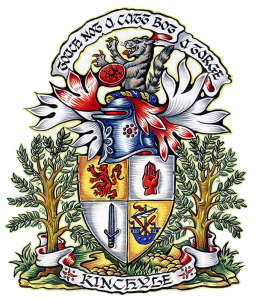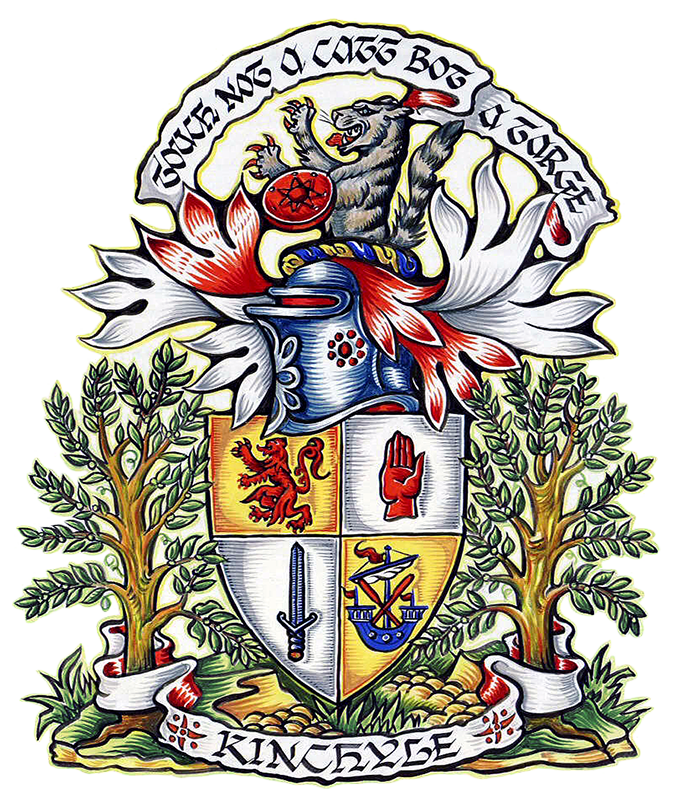Coat of Arms
The arms that appear on the front of the “Clan MacBean Register” are those arms granted by the Lord Lyon King of Arms Edinburgh Scotland to James McBain of McBain and are considered the personal property of the Chief. The Chief has given permission to use HIS arms on the Register.
In the United Kingdom the following rule applies: “According to the laws of heraldry in Scotland it is not legal for anyone to display as of personal right a coat of arms that has not been granted to him or her personally. People who ignore the law in this matter, not only look very foolish, but would under certain circumstances lay themselves open to prosecution.”
Many organizations around the world offer “family” arms for sale to be displayed by people with the name associated with the arms. In regard to Scottish arms, these offerings are not legal in the UK. Scotland is one of very few countries in the world which has a court to enforce the proper use of arms, namely the Lord Lyon Court of The King of Arms.
Those who can prove ancestry from Scotland may apply to this court for their own arms which will likely follow closely (but not exactly) the arms of the Chief To apply, simply write to Lord Lyon King of Arms, Register House, Edinburgh, Scotland, UK.

Motto
The elements of the Arms are a pictorial history of the Clan MacBean and where it came from. The Crest includes the motto at the top. It was changed slightly in 1958 from Touch not a catt bot a glove” to avoid the duplication with other Clans of Clan Chattan.
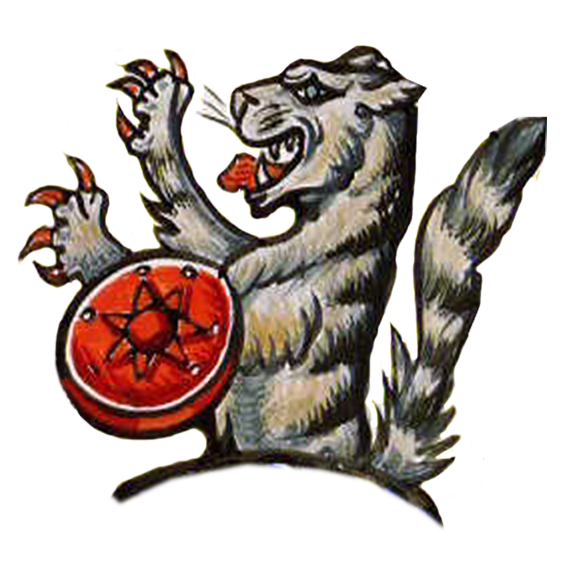
Demi-wildcat
To demonstrate affiliation with our clan we recommend use of the adage which forms the top of the Arms. In our case it is a demi-wildcat with a (red) targe Cor shield) on the foreleg, and the motto ‘TOUCH NOT A CATT BOT A TARGE” engraved on a belt and buckle surrounding the cat and targe. The buckle signifies allegiance to the Chief.
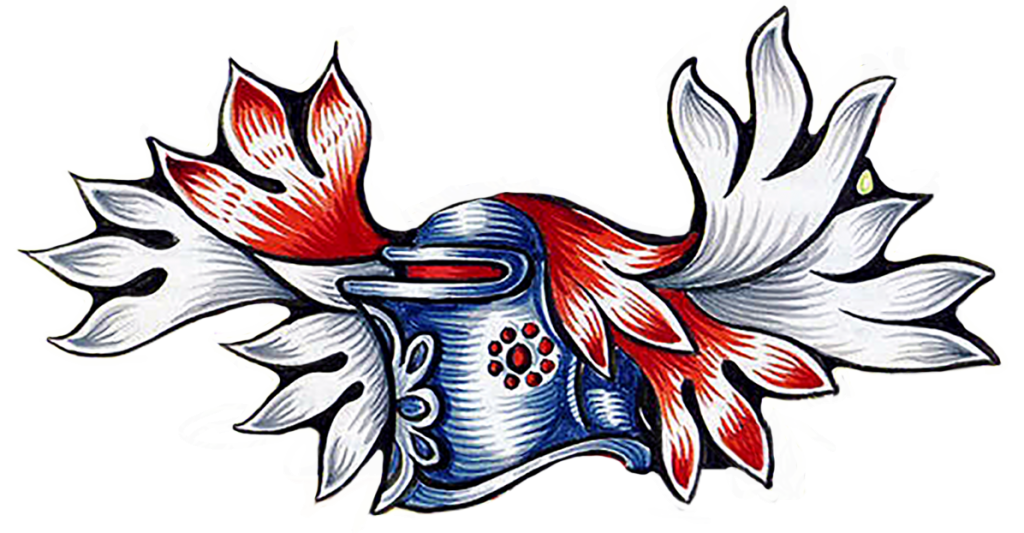
Helmet and Livery
Below the mantling is the helmet — the appearance of the helmet indicates the rank of the wearer. The Royal Family would have a gold one, Knights — steel with open visor, Barons — elaboration plus gold trim, Esquires and Gentleman — steel “pot design”. The Chiefs of the Clan MacBean are also Barons (of Kinchyle). Baron is a lesser title in Scotland than Chief.

Mantling
Just below the Catt is the mantling, a cloth designed originally to protect the wearer from the sun. In the matriculation granted to Hughston and later to James the colors are blue and yellow.

Red Lyon
In the most important part of the shield is the symbol of the Red Lyon, the ultimate representation of the Monarch of the Scots. It dates back to the time when we were living in the Kingdom of Dalriada (later Lorn), before our relationship with the Mackintoshes, before the time of Eva and probably before we identified ourselves under the name MacBean. The meaning is clear that we were a cadet of the old royal house, and despite few numbers and lack of wealth or power, our position was respected by other Chiefs and their families. We represented the Crown of what was to become Scotland.
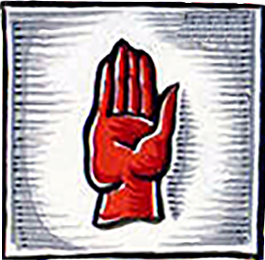
The Red Hand
This emblem is in the second most powerful position on the Arms Shield. Today it is commonly associated with the County of Ulster in the North of Ireland. There is significant history to prove that before they came to Scotland the people known as Scots resided in what is now Ireland- The most powerful symbol of those Scots was the noble lineage Ui Neill or O’Neill. Before we had surnames this was the term for the ruling monarch. The famous legend of the “Red Hand” has several versions including the story of a powerful ruler who had too many sons! The land he possessed was to be divided among them but one island that all sons coveted could not be awarded without causing great family division. A plan was set in motion. Each of the sons was given a boat to paddle to the desired island. They all started at the same distance from the destination. The island was to be awarded to the first one of the sons to claim possession by placing his hand on the island. There was a furious volley of paddling and yelling as they started out. Within yards of the island one of the sons began falling behind, but he was so determined to claim the land that, taking his dirk (medium sized knife) in his left hand, He cut off His right hand and threw it onto the shore. He was the first to claim the land by rule! Thus the story of the bloody hand. This legend is also found in the stories of the Sommerled Chief of what was to become the MacDonalds.
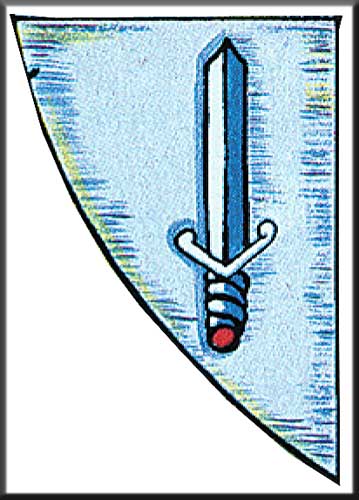
The Sword
This emblem is in the second most powerful position on the Arms Shield. Today it is commonly associated with the County of Ulster in the North of Ireland. There is significant history to prove that before they came to Scotland the people known as Scots resided in what is now Ireland- The most powerful symbol of those Scots was the noble lineage Ui Neill or O’Neill. Before we had surnames this was the term for the ruling monarch. The famous legend of the “Red Hand” has several versions including the story of a powerful ruler who had too many sons! The land he possessed was to be divided among them but one island that all sons coveted could not be awarded without causing great family division. A plan was set in motion. Each of the sons was given a boat to paddle to the desired island. They all started at the same distance from the destination. The island was to be awarded to the first one of the sons to claim possession by placing his hand on the island. There was a furious volley of paddling and yelling as they started out. Within yards of the island one of the sons began falling behind, but he was so determined to claim the land that, taking his dirk (medium sized knife) in his left hand, He cut off His right hand and threw it onto the shore. He was the first to claim the land by rule! Thus the story of the bloody hand. This legend is also found in the stories of the Sommerled Chief of what was to become the MacDonalds.

The Galley
The Galley in heraldry takes two forms: 1) The oars are in a rowing position. This may indicate a striving for battle or some distant shore. 2) The oars are crossed as in our case. This indicates a peaceful arrival. In Scottish lore the Galley is a symbol of the Norse Vikings who had such a great impact on Scotland from around 1100 to 1300. They are blamed for raids on the monasteries and the towns and villages around the perimeter of Scotland, England and Ireland. Many of them over the years married into Scottish families and were accepted as worthy members. The common name in Scotland today “Lochlan” means Viking. Most came from what is now Norway and for many years the King of Norway held the Orkney and other islands as his own property. Celebrations are still held in the Shetland and Orkney Islands celebrating their Norwegian heritage. The Galley symbol was important in the Clan Chattan confederation, and with our association as a “blood” Clan of Chattan, we take it as our own in the fourth quarter of the MacBean shield.
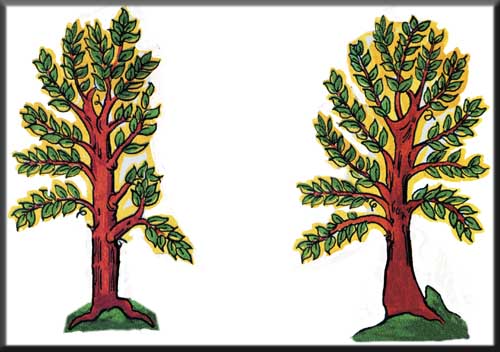
Supporters
There are generally Clan “Beasts” on either side of the Shield but in our case we have been awarded large boxwood trees.

Earth
Below the trees is a mound of earth representing the fact that the family has land in Scotland. The boxwood is our plant badge. In the days before Clan crests and even Clan tartans our family used the symbol of a plant native to our home area to distinguish ourselves from others.
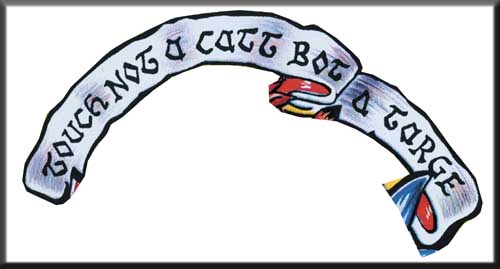
Kinchyle
Finally we have the clan war cry or slogan, KINCHYLE. This has evolved from the Gaelic Cean-Coille meaning “head of the forest”. It is a difficult attempt to translate the Gaelic into English. The Clan motto TOUCH NOT A CATT BOT A TARGE is a warning to outsiders meaning roughly “if you attempt harm on the family you are advised to protect yourself against aggression”. The motto is similar to the motto of Scotland which is “Nemo me impune lacessit” meaning roughly “you cannot attack me with impunity”.
